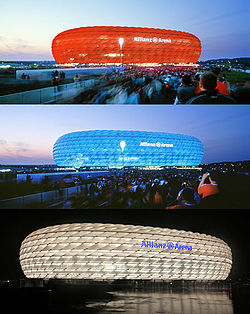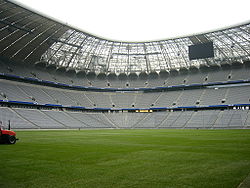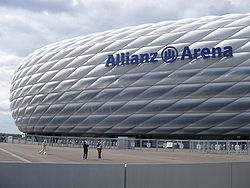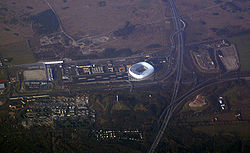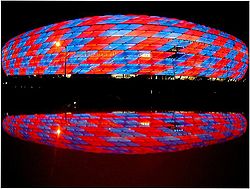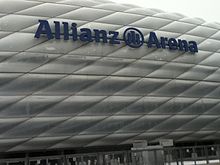- Allianz Arena
-
Allianz Arena Fußball Arena München
(during UEFA-organised games)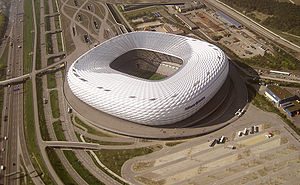
Former names FIFA World Cup Stadium Munich
(during the 2006 FIFA World Cup)Location Munich, Germany Broke ground October 21, 2002 Opened May 30, 2005 Owner Allianz Arena München Stadion GmbH Operator Allianz Arena München Stadion GmbH Surface Grass Construction cost € 340 million Architect Herzog & de Meuron
ArupSportCapacity 69,901 (seating and standing)
66,000 (seating only)Executive Suites 106 Field dimensions 105m x 69m Website Official Website Tenants FC Bayern Munich
TSV 1860 MünchenThe Allianz Arena is a football stadium in the north of Munich, Bavaria, Germany. The two professional Munich football clubs FC Bayern Munich and TSV 1860 München have played their home games at Allianz Arena since the start of the 2005–06 season. Both clubs had previously played their home games at the Munich Olympic Stadium since 1972, where FC Bayern Munich played all of their games and TSV 1860 München most of their games.
The large financial services provider Allianz purchased the rights to name the stadium for 30 years. During the 2006 World Cup it was known as FIFA World Cup Stadium Munich. Near Allianz Arena, Frottmaning U-Bahn station, on U6 can be seen.
The stadium will be the venue for the 2012 UEFA Champions League Final.[1]
Contents
Stadium specifics
The stadium is located at the northern edge of Munich's borough of Schwabing on the Fröttmaning Heath. It is the first stadium in the world that has a full changing color outside.
Capacity
Effective with the city's approval of modifications that was granted January 16, 2006, the legal capacity of the stadium has increased from 66,000 to 69,901 spectators (including standing room). The lower tier can seat up to 20,000, the middle tier up to 24,000, and the upper tier up to 22,000. 10,400 of the seats in the lower tier corners can be converted to standing room to allow an additional 3,120 spectators. The total capacity includes 2,000 business seats, 400 seats for the press, 106 luxury boxes with seating for up to 174, and 165 berths for wheelchairs and the like. From the second half of the 2005-06 Bundesliga season, the arena is able to accommodate 69,901 spectators at league and German Cup games, but because of UEFA regulations, the capacity remains at 66,000 seats for UEFA Champions League and UEFA Cup games. Bayern Munich has limited capacity during their league and cup games to 69,000. The partial roof covers all seats, although winds can still blow rain onto some of them.
Allianz Arena also offers three day-care centers and two fan shops, the FC Bayern Munich Megastore and the TSV 1860 München Allianz Arena Megastore. Merchandise is offered at stands all along the inside of the exterior wall inside the area behind the seats. Numerous restaurants and fast-food establishments are also located around the stadium.
There are four team locker rooms (one each for the two home teams and their respective opponents), four coaches' locker rooms, and two locker rooms for referees. Two areas are provided where athletes can warm up (approx. 110 m² each). There are also 550 toilets and 190 monitors in the arena.
Construction
- Total concrete used during stadium construction: 120,000 m³
- Total concrete used for the parking garage: 85,000 m³
- Total steel used during stadium construction: 22,000 tonnes
- Total steel used for the parking garage: 14,000 tonnes
The arena facade is constructed of 2,874 ETFE-foil air panels that are kept inflated with dry air to a differential pressure of 0.038 hPa. The panels appear white from far away but when examined closely, there are little dots on the panels. When viewed from far away, the eye combines the dots and sees white. When viewed close up however, it is possible to see through the foil. The foil has a thickness of 0.2 mm. Each panel can be independently lit with white, red, or blue light. The intention is to light the panels at each game with the colors of the respective home team, or white if the home team is the German national football team or on a neutral venue like the 2012 Final of UEFA Champions League. Multicolor Lightings are also possible, but Munich Police now insist on one-color only due to several car accidents on the nearby autobahn A9 with drivers being distracted by the changing lights. (In the US, a similar scheme is used for MetLife Stadium, which lights up in blue for the Giants, green for the Jets, and red for a concert.)
To light Allianz Arena up for one hour costs about 50 Euros (75 USD). Roller blinds installed under the roof may be drawn during games to provide protection from the sun.
Transport
Patrons may park their cars in Europe's largest parking structure, comprising four 4-story parking garages with 9,800 parking places. In addition, 1,200 places were built into the first two tiers of the arena, 350 places are available for buses (240 at the north end, and 110 at the south entrance), and 130 more spots are reserved for those with disabilities.
The stadium is located next to the Fröttmaning U-Bahn station. This is on the U6 line of the Munich U-Bahn.
Surroundings
From the subway station just south of the arena, visitors approach the stadium through a park that was designed to disentangle and guide them to the entrance. An esplanade rises gradually from ground level at the subway station entrance, passing the parking garage, to the entrance level of the stadium. On the other side of the Autobahn, the Fröttmaning Hill with its windmill affords a marvellous view on the stadium. Also the Romanesque Heilig-Kreuz-Kirche is located there together with its copy, an artwork in concrete as a reminder for the village of Fröttmaning which disappeared with the construction of the Autobahn.
Owners
The arena was commissioned by the Allianz Arena München Stadion GmbH, founded in 2001, and was owned in equal parts by the two football clubs that call it home. The GmbH's CEO was Karl-Heinz Wildmoser, Jr. until the unraveling of the stadium corruption affair (see below). Since then, Bernd Rauch, Peter Kerspe, and Walter Leidecker have led the company. In April 2006, FC Bayern Munich bought out TSV 1860 München's 50% share in the arena for a reported 11 million Euros. 1860's managing director Stefan Ziffzer stated that the deal prevented insolvency for the club. The terms of the agreement give 1860 the right to buy back their 50% share of the arena for the price of sale plus interest anytime before June 2010. In November 2007 TSV 1860 München resigned that right. In advance, the income of two friendly-games both clubs shared equally instead of having that money going to Allianz Arena GmbH. Due to financial turbulences of TSV 1860 München, FC Bayern Munich took over all the sharings and now owns 100% of the Allianz Arena.
Name
The Allianz paid significant sums for the right to lend its name to the stadium for a duration of 30 years.
Cost
The cost of the construction itself ran to €286 million but financing costs raised that figure to a total of €340 million. In addition, the city and State incurred approximately €210 million for area development and infrastructure improvements.
Reactions
On November 14, 2005 at the annual general meeting, many FC Bayern Munich club members complained about the uncomfortable draft inside the arena. As a result, closable doors were installed and spectators now enjoy watching the games in greater comfort.
The Ultras and many other fans protested at several home games against the seats and some of the rules of the arena which they perceive as "fan unfriendly". For example, a spectator may not enter with a megaphone or a pennant that a single person cannot carry unfurled, and pennant poles with a length of over one metre are prohibited. The complaint is that these rules and the designer seats put a damper on the fan experience. The presence of a large fence and safety nets in front of the southern curve (seat bloc reserved for fans of the FC Bayern Munich) are also often criticized.
These complaints have had some success. From the 06/07 season blocks 112 and 113 have been converted into terracing, in the usual German style so that seats can be installed for UEFA and international matches, whose regulations demand seating for all spectators.
In reaction to the heavy commercialisation that followed the rejection of the Ultra movement in the media, and some other actions of the FC Bayern Munich football club, the stadium has sometimes been dubbed Arroganz Arena ("Arrogance Arena").
History
On October 21, 2002 voters went to the polls to determine whether a new stadium should be built in this location and whether the city of Munich should provide the necessary infrastructure. About two thirds of the voters decided in favor of the proposition. An alternative to constructing the new arena had been a major reconstruction of the Olympic Stadium but this option had been refused by its architect Günther Behnisch.
The Swiss architect firm of Herzog & de Meuron then developed the concept of the stadium with a see-through exterior made of ETFE-foil panels, that can be lit from the inside and are self-cleaning. Construction started in the autumn of 2002 and was completed by the end of April 2005.
The Fröttmaning and Marienplatz stations of the subway line U6 were expanded and improved in conjunction with the arena construction. The Fröttmaning subway station was expanded from two to four tracks, while the Marienplatz U-Bahn station was outfitted with additional pedestrian connector tunnels running parallel to the subway tracks, which lead towards the S-Bahn portion of the station, lessening congestion among passengers making connections to the Munich S-Bahn. To be able to handle the additional traffic load, the Autobahn A9 was expanded to three and four lanes going each way and another exit was added to the A99 north of the arena.
Stadium corruption affair
Since March 2004, a corruption affair relating to the stadium has occupied the football world and German courts. On March 9, Karl-Heinz Wildmoser, Sr., president of the TSV 1860 München, his son Karl-Heinz Wildmoser, Jr., chief executive officer of Allianz Arena München Stadion GmbH, and two others were charged with corruption in connection with the award of arena construction contracts and taken into custody. On March 12, 2004, Wildmoser, Sr. struck a plea bargain and was released. As part of the plea bargain, he relinquished the presidency of the club three days later, and on May 18, the investigation into his conduct was closed.
His son, Karl-Heinz Wildmoser, Jr., remained in custody. At a bail hearing on June 29, the judge refused bail on the grounds of danger of flight and obstruction of justice. The District Attorney filed charges on August 23, 2004, accusing him of fraud, corruption and tax evasion. The case was that Wildmoser, Jr. had awarded the construction contract at an inflated price, provided the Austrian builder Alpine with inside information that enabled the builder to win the contract, and in return received €2.8 million.
On May 13, 2005, Karl-Heinz Wildmoser, Jr. was convicted and sentenced by a Munich court to four and a half years in prison. He was released on bail pending his appeal. The Federal Court of Justice rejected the appeal in August 2006.
Opening day
On May 30, 2005, TSV 1860 München played an exhibition game against 1. FC Nuremberg. The next day the record German champions Bayern Munich played a game against the German national team. Both games had been sold out since early March 2005. Patrick Milchraum of TSV 1860 scored the first official goal at the stadium.
On June 2, in response to high demand, the first "arena derby" took place between the two owners. That game was won by TSV 1860 with the help of a goal by Paul Agostino.
Prior to opening day the alumni teams of both clubs played each other in an exhibition game in front of a crowd of 30,000 where all stadium functions were thoroughly tested.
The stadium's first goal in a competitive game went to Owen Hargreaves of FC Bayern when the home team won 3–0 in its 2005/06 Bundesliga season opener against Borussia Mönchengladbach on August 5, 2005. The first goal in an official game by a visiting team was scored by Dynamo Dresden on September 9, 2005 in the Second Bundesliga match against TSV 1860 München. That game ended in a score of 1–2 in front of a full house which included approximately 20,000 - 22,000 fans who had traveled to Munich from Dresden for the game. Dresden thus became the first visiting team to win a competitive game at Allianz Arena.
The first goal against FC Bayern Munich in a league game at Allianz Arena was scored by Miroslav Klose of SV Werder Bremen on November 5, 2005 in the first minute of play. This was to remain the visitors' only goal that day as the game went to the FC Bayern with a final score of 3–1.
FC Bayern broke its consecutive sell-out record by selling out each of its first ten home games at Allianz Arena.
2006 FIFA World Cup
The stadium was one of the venues for the 2006 FIFA World Cup. However, due to sponsorship contracts, the arena was called FIFA World Cup Stadium Munich during the World Cup.
The following games were played at the stadium during the World Cup of 2006:
Date Time (CEST) Team #1 Res. Team #2 Round Spectators 2006-06-09 18.00  Germany
Germany4–2  Costa Rica
Costa RicaGroup A (opening match) 69,451 2006-06-14 18.00  Tunisia
Tunisia2–2  Saudi Arabia
Saudi ArabiaGroup H 69,451 2006-06-18 18.00  Brazil
Brazil2–0  Australia
AustraliaGroup F 69,451 2006-06-21 21.00  Côte d'Ivoire
Côte d'Ivoire3–2  Serbia and Montenegro
Serbia and MontenegroGroup C 69,451 2006-06-24 17.00  Germany
Germany2–0  Sweden
SwedenRound of 16 69,451 2006-07-05 21.00  Portugal
Portugal0–1  France
FranceSemifinals 69,451 See also
References
External links
- Official website of Allianz Arena Facts and Figures Section provides details like the amount of concrete used, composition of the facade, facade lighting etc. (English)
- Photos and Videos of Allianz Arena at footballmatch.de
- Allianz Arena at Structurae
TSV München von 1860 Information Stadia Rivalries Fußball-Club Bayern München Information Stadia Other teams Seasons 1965–66 · 1966–67 · 1967–68 · 1968–69 · 1969–70 · 1970–71 · 1971–72 · 1972–73 · 1973–74 · 1974–75 · 1975–76 · 1976–77 · 1977–78 · 1978–79 · 1979–80 · 1980–81 · 1981–82 · 1982–83 · 1983–84 · 1984–85 · 1985–86 · 1986–87 · 1987–88 · 1988–89 · 1989–90 · 1990–91 · 1991–92 · 1992–93 · 1993–94 · 1994–95 · 1995–96 · 1996–97 · 1997–98 · 1998–99 · 1999–2000 · 2000–01 · 2001–02 · 2002–03 · 2003–04 · 2004–05 · 2005–06 · 2006–07 · 2007–08 · 2008–09 · 2009–10 · 2010–11 · 2011–12Rivalries Related articles Franz-Beckenbauer-CupBundesliga venues (2011–12) Allianz Arena · AWD-Arena · BayArena · Borussia-Park · Coface Arena · Dreisamstadion · Frankenstadion · Fritz-Walter-Stadion · Mercedes-Benz Arena · Olympiastadion · RheinEnergieStadion · Rhein-Neckar-Arena · SGL arena · Veltins-Arena · Volksparkstadion · Volkswagen Arena · Weserstadion · Westfalenstadion2. Fußball-Bundesliga venues (2011–12) Allianz Arena · Audi Sportpark · Commerzbank-Arena · DKB-Arena · Eintracht-Stadion · Energieteam Arena · Erzgebirgsstadion · Esprit Arena · Glücksgas Stadium · Millerntor-Stadion · MSV-Arena · New Tivoli · Ruhrstadion · Stadion An der Alten Försterei · Stadion der Freundschaft · Trolli Arena · Volksbank Stadion · Wildparkstadion
2006 FIFA World Cup Stadiums FIFA WM-Stadion Dortmund (Dortmund) · FIFA WM-Stadion Frankfurt (Frankfurt) · FIFA WM-Stadion Gelsenkirchen (Gelsenkirchen) · FIFA WM-Stadion Hamburg (Hamburg) · FIFA WM-Stadion Hannover (Hanover) · FIFA WM-Stadion Köln (Cologne) · FIFA WM-Stadion München (Munich) · Frankenstadion (Nuremberg) · Fritz-Walter-Stadion (Kaiserslautern) · Gottlieb-Daimler-Stadion (Stuttgart) · Olympiastadion (Berlin) · Zentralstadion (Leipzig)Preceded by
Wembley Stadium
LondonUEFA Champions League
Final Venue
2012Succeeded by
Wembley Stadium
LondonCoordinates: 48°13′7.59″N 11°37′29.11″E / 48.218775°N 11.6247528°E
Categories:- Event venues established in 2005
- 2006 FIFA World Cup stadiums
- Sport in Munich
- Buildings and structures in Munich
- Herzog & de Meuron buildings
- Lattice shell structures
- High-tech architecture
- Postmodern architecture
- Modernist architecture in Germany
- Visitor attractions in Munich
- Football venues in Germany
- FC Bayern Munich
- TSV 1860 München
Wikimedia Foundation. 2010.

